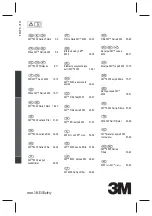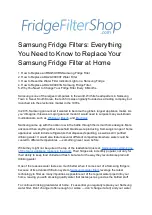
5
RO SYSTEM
The purpose of a Reverse Osmosis (RO) water treatment system is to separate dissolved solids from
water. This unit will provide up to 120 gallons of potable water per day.
Incoming water from the supply is pressurized by a booster pump to about 185 psi. The water is forced
against a semi-permeable membrane which passes the water and rejects or blocks particulates and
dissolved solids. The concentrated salts and solids pass out of the unit and flow to drain.
Recovery of an RO unit is the ratio of the pure water created to the feedwater coming into the unit. Design
recovery for this unit is about 80%. This means that in order to produce 120 gallons of pure water, about
150 gallons of feedwater is required, with about 30 gallons of concentrated reject going to drain.
Some things that can reduce water production or upset the recovery are:
•
Very high TDS feedwater. Higher levels of contaminants (dissolved solids or organics) require higher
pressures in order to obtain the same product flow. This system has a maximum operating pressure
of 190psig.
•
Cold feedwater. Each 1 degree (Centigrade) of supply water change will result in about a 2% change
in water production. If the feedwater temperature drops from 23°C to 18°C, you will get about 10%
less water production.
•
Reduced feed pressure. Inlet feed pressure (ie: municipal supply, well pump) will directly affect the
membrane feed pressure. Reducing the membrane feed pressure will reduce the amount of water
produced.
•
Clogged inlet filters. As pre-filters age and collect debris, the pressure drop across the filter increases
and flow decreases. At some point, the reduced pressure or flow may actually cause the system to
not operate at all.
•
High pH feedwater. At high pH levels, systems are not only less efficient, but the membranes tend to
scale more rapidly. This will also reduce water production.
•
Fouled membranes. Scaling, (mineral deposits) and biofouling, (biological growth) either on the
membranes on within the RO unit will reduce production. Both causes may be corrected by prompt
cleaning with a suitable chemical solution. If detected early, system performance may return to
“nearly new” condition.
•
Old membranes. As membranes age, water production may decrease or salt passage may increase.
In either case, it is time to buy a new membrane for your system. Nominal life expectancy where
performance at least meets the minimum specifications for the system is about 3 years. The typical
useful life may be as long as 7 or 8 years with care and excellent feedwater quality.
INSTALLATION
1. This RO system requires an adequate water supply, with a line pressure of
40 PSI
, within 6
feet of the installation site. This will insure adequate feed pressure to the booster pump after
any filtration.
WARNING:
A pressure regulator must be used if the feedwater pressure exceeds a
maximum of 50 PSI.
IMPORTANT:
When installing a RO system that utilizes a booster pump in an enclosed
area such as under a kitchen sink, be sure that there is adequate ventilation to dissipate
the heat from the motor. Otherwise the heat buildup can weaken the plastic tubing and
may cause it to burst under pump pressure.
Summary of Contents for CAK Series
Page 12: ...12...































